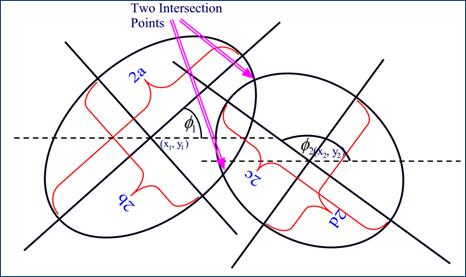|
C |
Ellipse Hazard |
Finding the intersection of two arbitrary ellipses can be tricky. Actually even the intersection of two axis-parallel ellipses can be tricky, let alone ellipses that are in rotated position like the two shown below:
 For
two arbitrary ellipses, the following cases can occur:
For
two arbitrary ellipses, the following cases can occur:
(a) They do not intersect.
(b) They intersect each other in two points.
(c) They intersect each other in four points.
(d) They touch each other in one point.
(e) They touch each other in one point and intersect in another two points.
(f) They touch each other in two points.
In this problem you will not have to detect whether two ellipses touch each other as the given ellipses will not touch each other: They will either intersect each other in 2 or 4 different points or will not intersect. In other words you will have to deal with only situation (a), (b) and (c).
Input
There will be around 6000 cases for this problem.
Each case contains 10 integers x1, y1,
a, b, ![]() , x2,
y2, c, d,
, x2,
y2, c, d, ![]() .
Here
.
Here
a) (x1, y1) = Coordinate of the center of first ellipse (0 ≤ x1, y1 ≤ 1000).
b) (x2, y2) = Coordinate of the center of the second ellipse (0 ≤ x2, y2 ≤ 1000).
c) a = length of semi-major axis of first ellipse (10 ≤ a ≤ 500).
d) b = length of semi-minor axis of first ellipse (10 ≤ b ≤ 500).
e) c = length of the semi-major axis of second ellipse (10 ≤ c ≤ 500).
f) d = length of the semi-minor axis of second ellipse (10 ≤ d ≤ 500).
g)
![]() = angle (in degrees) the major axis of the
first ellipse creates with the positive direction of x-axis (0 ≤
= angle (in degrees) the major axis of the
first ellipse creates with the positive direction of x-axis (0 ≤ ![]() ≤ 360).
≤ 360).
h) ![]() = angle (in degrees) the major axis of second ellipse
creates with the positive direction of x-axis (0 ≤
= angle (in degrees) the major axis of second ellipse
creates with the positive direction of x-axis (0 ≤ ![]() ≤ 360).
≤ 360).
Input is terminated by a case where the value of a, b, c and d are negative. This case should not be processed.
Output
For each case, produce two, three or five lines of outputs. The first line contains the serial of output. If the two ellipses do not intersect then in the next line print the line "Do_not_intersect." If the ellipses intersect in two points then print two floating-point numbers in two lines and if the ellipses intersect in four points then print four floating-point numbers in four lines. These floating-point numbers are actually summation of abscissa and ordinate of the intersection points. These numbers should be printed in ascending order and should have eight digits after the decimal point. Errors less than 10-5 will be ignored.
Sample Input |
Output for Sample Input |
|
755 216 313 109 130 671 997 355 85 338 861 654 216 319 300 936 910 338 483 318 653 819 271 144 325 145 959 145 49 185 653 819 -1 -1 325 145 959 -1 -1 185 |
Case 1: Do_not_intersect. Case 2: 1173.83963384 1754.28733987 Case 3: Do_not_intersect. |
Problem Setter: Shahriar Manzoor, Special Thanks: Jane Alam Jan